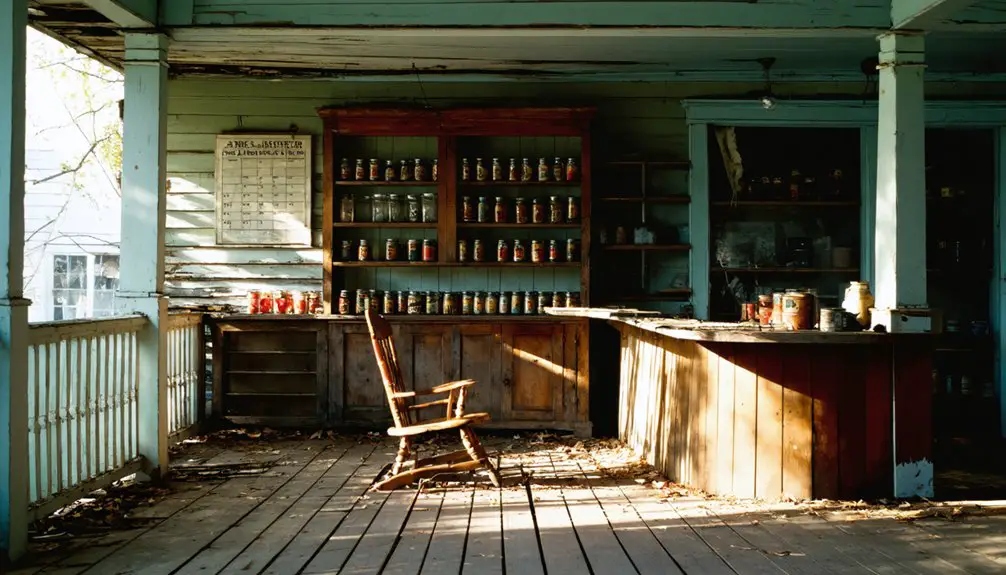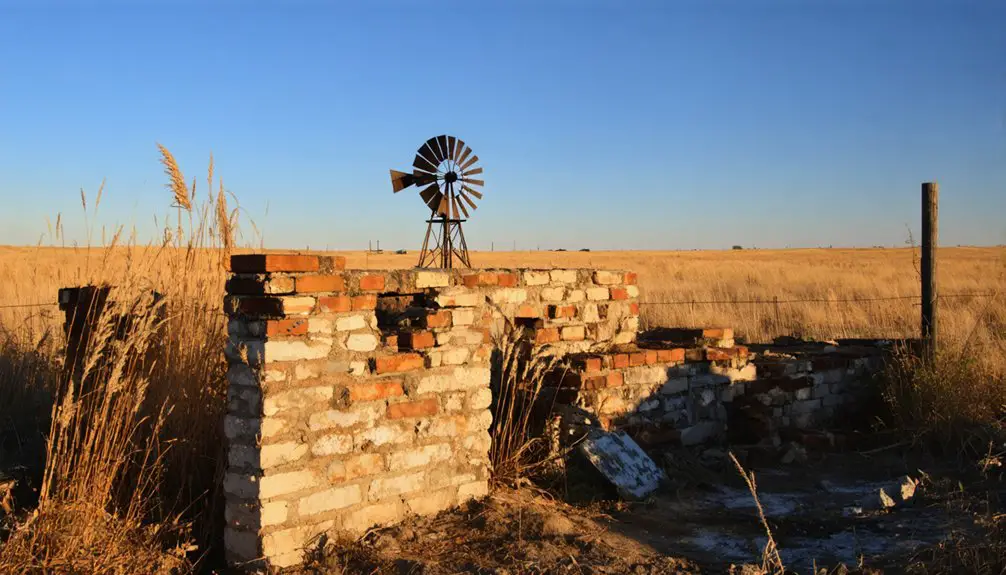You’ll find Hanson’s fascinating story in northeastern Oklahoma, where this former boomtown reached its peak in 1926 with 15,000 residents. The town flourished due to rich zinc and lead deposits, with railroads connecting it to major trade routes. Community life centered around mining activities, schools, and vibrant social gatherings in saloons and dance halls. Today, few physical remnants remain, though the site’s historical significance continues to draw those interested in Oklahoma’s mining heritage.
Key Takeaways
- Hanson was a booming mining town in Oklahoma that reached its peak population of 15,000 residents in 1926.
- The town’s economy primarily relied on zinc and lead mining, with additional support from oil discovery and small-scale farming.
- Community life centered around schools, churches, and social gatherings, including regular festivals and cultural events.
- Transportation route changes and resource depletion led to Hanson’s eventual abandonment and ghost town status.
- Few physical structures remain today, with most of the townsite reverting to agricultural use or natural vegetation.
Origins and Early Settlement
While the Osage Nation and other Native American tribes originally inhabited the land around Hanson, the town’s official founding came in the early 1900s during Oklahoma’s territorial period.
You’ll find the early inhabitants settled near established Native American trade routes and gathering places, where the Osage people had maintained significant cultural and economic activities.
Similar to Picher which was established in 1913 after lead, the town emerged as oil and mining opportunities drew settlers to the region, quickly establishing crucial infrastructure including a post office, general store, and blacksmith shop.
The railroad’s presence helped shape Hanson’s development, connecting it to other communities while serving as a local hub for families and travelers.
Though small in population, the town created a crucial trading point between settlers and Native American communities. Like other communities during this era, they built a main East-West road to facilitate business growth and trade between neighboring settlements.
Life During the Boom Years
As Hanson evolved from its early settlement days, the mining industry transformed the once-quiet town into a bustling hub of activity. You’d find thousands of workers descending into dangerous mine shafts daily, while their families shopped at the company store and gathered supplies from local merchants. Like many of Oklahoma’s lead and zinc operations, the mines were crucial to the town’s growth.
Despite harsh conditions, Hanson’s community resilience shone through in the way residents came together at local schools and churches. The town’s cultural identity centered on mining life, with social activities revolving around work shifts and local celebrations. Similar to the mining disaster at Adamson Mine One, underground dangers were a constant threat to workers’ lives.
You could catch workers riding trolleys between mines, while railroad cars hauled coal away day and night. Life wasn’t easy – you’d face the constant threat of mine accidents and harsh working conditions – but the tight-knit community supported one another through both prosperity and hardship.
Economic Rise and Peak Period
You’ll find Hanson’s early commercial development was fundamentally shaped by the region’s rich zinc and lead deposits, which attracted miners, merchants, and investors to the area.
The arrival of railroad connections transformed Hanson into a crucial trade hub, enabling efficient transport of ore and supplies between mining operations and distant markets. Similar to how railroad routing affected other Oklahoma towns, some neighboring settlements declined as Hanson’s transportation advantages grew.
Local businesses flourished as mining payrolls circulated through the community, supporting everything from equipment suppliers to retail shops that served the growing population. The town experienced remarkable growth, reaching a peak of 15,000 residents in 1926.
Early Commerce Development
Three key economic pillars shaped Hanson’s early commercial development in the 1920s and 1930s. Small-scale farming formed the foundation, with farmers growing staple grains and vegetables while raising livestock for local trade.
You’d find active barter systems and seasonal markets supporting this agricultural backbone. Similar to the Keyes railroad boom, Hanson’s growth accelerated when train service connected the town to regional markets.
The discovery of oil in the late 1920s brought a surge of economic activity, creating jobs and attracting businesses focused on oilfield supplies. Much like the salt works near Salina, these natural resources drove local industry.
The 1926 establishment of a post office marked Hanson’s growing commercial significance. You could find blacksmith shops, repair facilities, and general stores serving both town residents and the surrounding rural population.
These businesses thrived on direct community demand, with local craftsmen and grocers emerging to meet the needs of a population that had grown to several hundred residents.
Railroad Trade Impacts
While farming and oil shaped Hanson’s early growth, the arrival of railroads propelled the town into an era of unprecedented prosperity. You’d find the Missouri, Kansas & Texas Railroad’s expansion into Indian Territory transforming Hanson into a bustling trade hub by the early 1870s.
The town’s strategic position along multiple rail lines created extensive trade networks, connecting local merchants to markets in Denison, Texas, and Oklahoma City. The Chisholm Trail cattle trade significantly boosted the town’s economic importance as a railway shipping point. Local merchants earned $1.00 per train to use the railway wye for turning operations.
Between 1897 and 1907, you’d witness Hanson’s golden age as competing railroad companies converged on the area. The town became a crucial nexus for shipping coal, cotton, and livestock.
Railroad operations brought diverse employment opportunities, from mining and freight handling to passenger services. This railway-driven boom established Hanson as a key commercial center, attracting merchants, warehouses, and supply stores.
Notable Buildings and Landmarks
Throughout Hanson’s quiet streets, several historic structures stand as silent witnesses to the town’s more vibrant past.
You’ll find an Art Deco theater from 1947, complete with a unique “crying room” for children, though its deteriorating roof signals the urgent need for theater restoration.
The abandoned hotel and bar on Main Street, once a bustling social center, tells a story of the town’s economic peaks and valleys.
The vacant Main Street hotel stands frozen in time, a weathered monument to Hanson’s rise and decline.
The former high school, now repurposed by a local farmer, reflects the community’s adaptation to change.
Scattered along Main Street, you’ll discover various commercial buildings, from old convenience stores to service stations, all echoing the hotel history and broader story of small-town Oklahoma.
While many structures face demolition, they remain evidence of Hanson’s historical significance.
Daily Life and Social Structure

Life in Hanson had a strong community focus, with residents gathering regularly at local businesses and events to maintain social bonds despite the town’s small population of 214.
The young median age of 18.4 years shaped daily routines around education and family activities, while the presence of multiple generations contributed to the transfer of local traditions and knowledge.
Business relationships remained intimate and personal, with local trade reflecting the town’s modest $76,396 average household income and its reliance on farming and oil-related economic activities.
Community Gatherings and Events
During Hanson’s peak years, social gatherings formed the heart of community life, with the town’s saloons and dance halls serving as primary meeting spots for both locals and travelers.
You’d find regular community festivals bringing together residents for seasonal celebrations, barbecues, and outdoor entertainment. These social traditions helped forge strong bonds between families and neighbors during both prosperous and challenging times.
When formal law enforcement was scarce, the community relied on informal networks to maintain order during public events.
Local talent would organize musical performances and theatrical acts, while traveling entertainers brought fresh entertainment to the town. The community hall hosted regular dances and celebrations, while informal sporting events like baseball games and horse races drew crowds together, strengthening the town’s social fabric.
Education and School Life
As Hanson developed in the late 1800s, its educational landscape reflected the complex social dynamics of Indian Territory, with three distinct school systems operating in the area. You’d find mission schools, subscription-based education, and Cherokee National Schools, each serving different segments of the population.
School traditions and educational practices varied considerably across these institutions:
- Cherokee National School charged white students 50 cents monthly while serving Native children.
- Students often rode horseback to attend classes, with girls adapting their riding style to social norms.
- School grounds doubled as cultural centers, hosting Green Corn dances and community gatherings.
- Teachers like Nora Bradley weren’t just educators but essential community figures.
- Facilities evolved from private homes to two-room schoolhouses as the population grew.
Business and Trade Relations
The bustling commercial heart of Hanson thrived on three key economic pillars: agriculture, local trade, and transient business from nearby travel routes. You’d find merchants and storekeepers operating general stores that served as commercial hubs, where barter systems flourished alongside cash transactions for essential goods and services.
The town’s economic structure centered around local businesses like saloons, repair shops, and hotels catering to both residents and travelers. These establishments formed the backbone of daily commerce, while nearby railroad connections influenced trade viability.
You might’ve encountered farmers trading agricultural products, cattle drivers stopping for supplies, or oil field workers seeking services. The social hierarchy reflected typical frontier dynamics, with business owners and merchants holding considerable influence in the community’s economic affairs.
Factors Leading to Decline

Multiple interrelated factors contributed to Hanson’s transformation from a thriving community into an Oklahoma ghost town. The town’s economic vulnerabilities and transportation isolation created a perfect storm that led to its eventual abandonment.
You’ll find that several key developments sealed Hanson’s fate:
- Changes in regional transportation routes left the town cut off from essential trade networks
- The local economy couldn’t diversify beyond its initial resource-based foundation
- Population shifts toward larger urban centers drained the community of its workforce
- Natural resource depletion eliminated primary sources of employment
- Limited access to markets and supplies made it increasingly difficult for businesses to remain competitive
These compounding factors created a downward spiral, as each challenge made it harder for residents to justify staying in a town with diminishing opportunities and resources.
Last Active Years
Hanson’s final chapter as an active community unfolded during the mid-20th century, marked by a series of closures and departures that signaled its transformation into a ghost town.
You’ll find the last population trends followed patterns typical of Oklahoma ghost towns, with residents steadily departing during and after the Great Depression. The post office’s closure dealt a significant blow to the remaining community, while the loss of rail service accelerated the town’s decline.
In its final years, Hanson’s economic activity dwindled to almost nothing. A few caretakers and farmers remained as the last residents, but by the 1950s-60s, the town had fundamentally ceased to function.
The land eventually reverted to agricultural use, with any remaining structures left to deteriorate naturally.
Physical Remains Today

If you visit the former townsite of Hanson today, you’ll find few visible remnants of the once-active community, with most above-ground structures having completely disappeared over time.
The landscape has largely returned to agricultural use or natural vegetation, making it challenging to identify exact locations of former buildings without careful examination of possible foundation remains or cellar holes.
Access to the site presents difficulties due to the absence of maintained roads within the former town boundaries and limited directional markers or signage to guide visitors.
Current Structural Remnants
While most structures in Hanson have vanished over time, the Quapaw Marshal’s Office stands as one of the few remaining official buildings in Oklahoma’s mining ghost town region.
Due to structural safety concerns and widespread contamination, you’ll find minimal physical remnants of this once-bustling mining community.
- Residential and commercial buildings have been systematically demolished following town buyouts.
- Environmental hazards from lead and heavy metals have compromised remaining foundations.
- Abandoned structures are unsafe and continue to deteriorate from weather exposure.
- Former mining infrastructure has been removed or sealed during cleanup operations.
- Roads remain but are often overgrown, with occasional remnants of fencing or abandoned equipment visible near the perimeter.
Location Access Challenges
Reaching the physical remains of Hanson today presents significant challenges due to its remote location in rural Oklahoma.
You’ll face limited highway access and poorly maintained, often unpaved roads that can become impassable during adverse weather. Remote navigation is particularly difficult due to minimal cellular coverage and unreliable GPS signals in the area.
Before attempting to visit, you’ll need to secure access permits since the site likely sits on private property.
The surrounding terrain presents additional obstacles, with overgrown vegetation concealing former pathways and potential hazards like abandoned wells. The absence of proper signage or markers further complicates locating the exact site.
Natural processes have reclaimed many original access routes, while modern development and infrastructure changes have altered historical approaches to the ghost town.
Historical Significance
As one of Oklahoma’s numerous ghost towns, Hanson exemplifies the boom-and-bust cycle that characterized many settlements during the late 19th and early 20th centuries.
The town’s cultural heritage and historical narratives reflect broader patterns of development and decline that shaped Oklahoma’s landscape.
Oklahoma’s towns like Hanson tell a familiar story of rise and fall, weaving together the threads of the state’s evolving identity.
- Railroad operations served as the town’s economic lifeline, determining its growth and eventual decline.
- Local institutions like schools and churches formed the backbone of community life.
- The town’s fortunes were tied to regional economic shifts, including agricultural changes and resource extraction.
- Native American populations and their communities influenced local social dynamics.
- Natural disasters and infrastructure changes, such as reservoir creation, impacted the town’s sustainability.
You’ll find that Hanson’s story mirrors many Oklahoma communities that rose and fell with changing transportation routes, economic conditions, and demographic shifts.
Preservation Efforts and Documentation
Despite its deteriorating physical remains, Hanson benefits from Oklahoma’s robust preservation infrastructure led by the State Historic Preservation Office (SHPO) and various documentation initiatives.
The “Tomorrow’s Legacy” plan guides preservation strategies through outreach, resource identification, and incentive programs that you’ll find essential for protecting ghost town heritage.
You can participate in preservation efforts through Preservation Oklahoma’s Most Endangered Places List nomination process, which mobilizes community support for threatened sites.
The “Ghost Towns In Oklahoma” project complements these formal preservation methods by gathering photographic evidence, historical data, and location details.
While you’ll face challenges like natural decay and limited funding, SHPO offers various incentives, including grants and tax credits, to support your preservation endeavors in places like Hanson.
Frequently Asked Questions
Are There Any Reported Paranormal Activities or Ghost Sightings in Hanson?
You won’t find any documented ghostly encounters or spectral sightings in this location. Historical records and paranormal research databases don’t list any supernatural activity in the former railroad stop.
What Valuable Artifacts Have Been Discovered in Hanson’s Ruins?
One man’s trash is another’s treasure! You’ll find projectile points, Mississippian pottery with bird claw designs, French gun parts, metal artifacts, and ceremonial objects throughout Hanson’s historic ruins.
Did Any Famous Outlaws or Historical Figures Visit Hanson?
You won’t find any documented famous visitors or outlaw legends connected to Hanson. Historical records and local archives don’t mention any notable figures stopping there during the town’s active years.
Are Metal Detecting or Archaeological Explorations Allowed in Hanson Today?
You’ll need explicit permission and proper permits for metal detecting or archaeological exploration. It’s allowed on private land with owner consent, but strict regulations and permit requirements apply for public areas.
What Native American Tribes Originally Inhabited the Area Before Hanson’s Establishment?
You’ll find rich tribal history in this area, where Wichita Confederacy peoples, including the Tawehash, originally lived alongside Caddo groups, with Plains Apache and various indigenous cultures later sharing these lands.
References
- https://en.wikipedia.org/wiki/List_of_ghost_towns_in_Oklahoma
- https://www.youtube.com/watch?v=wEoEZKBUsvs
- https://beerconnoisseur.com/articles/infamous-wild-west-ghost-town-beer-city-oklahoma/
- https://www.okhistory.org/publications/enc/entry?entry=GH002
- https://kids.kiddle.co/List_of_ghost_towns_in_Oklahoma
- https://www.youtube.com/watch?v=-jYN1_E2VV0
- https://quirkytravelguy.com/visiting-picher-oklahoma-ghost-town-toxic-waste/
- https://www.youtube.com/watch?v=5d-wHDTIbb0
- https://www.okhistory.org/publications/enc/entry?entry=PI002
- https://www.youtube.com/watch?v=AIyhx6xT-S8



